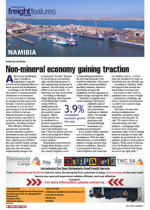Namibia’s oil and gas sector may still be in its infancy, but the country is already grappling with the pressures of rapid growth – a trend that Anton Pretorius, group managing director of Logistics Support Services (LSS), says has placed the spotlight firmly on logistics readiness.As a long-standing player in logistics, especially for the offshore oil and gas and repair service industries, LSS is leveraging its deep sector experience and transformation-focused strategy to position itself as a key enabler of Namibia’s energy ambitions.But with surging volumes through Walvis Bay, road infrastructure under strain and exploration activity booming, Pretorius warns that unless infrastructure development keeps pace, Namibia risks missing out on the full value of the coming oil and gas boom.“If you didn’t start preparing five years ago, you’re already too late – the oil and gas sector doesn’t wait, and you can’t build skills or credibility overnight. This is the time to deliver, not to start planning,” he says.As Namibia positions itself at the forefront of southern Africa’s oil and gas frontier, companies like LSS are racing to keep pace with the sector’s rapid evolution. With global majors such as TotalEnergies and Shell deep into exploration and appraisal phases, local service providers are under pressure to meet international standards, not only in infrastructure and operations, but also in skills, systems and governance.For LSS, a Namibian-owned logistics company with deep roots in marine support, oil and gas, and cross-border trade, the moment to step up has clearly arrived.“The important thing to understand is that exploration has brought many new players into the market. We’ve seen a real uplift in the industry – global players have opened bases in Walvis Bay and moved quickly,” says Pretorius. “At the same time, due to issues in some neighbouring countries, there’s been a massive inf lux of cargo for landlocked nations coming through Walvis Bay. The road infrastructure is under pressure, which shows just how busy it is here and the toll increased truck traffic is taking.”According to Pretorius, volumes have increased significantly in and out of Walvis Bay. “With all the imports, there’s now a big push to grow exports to fill the empty legs. The harbour is at full capacity and there’s no additional port space expected before 2030. The growth has been fast and that has been part of the challenge. You can only expand so much before you hit the same congestion issues that other ports are facing.”This isn’t limited to oil and gas – the mining sector is also experiencing a resurgence, driving even greater demand for logistics solutions. “There are at least two mines in the construction phase and many others in exploration. We’re also seeing major upgrades at several existing mines, and so demand for logistics services is high.”Pretorius believes the logistics sector is well placed to benefit from Namibia’s boom. “The sector is positioned very well, and Namibia is in a really good place right now,” he says. “But while we should be optimistic, we also need to be realistic – there’s only so much the infrastructure can handle. We shouldn’t try to take too big a bite out of the pie too quickly.“If we get this right now, Namibia has a real shot at becoming a logistics powerhouse in the region,” says Pretorius. LV

